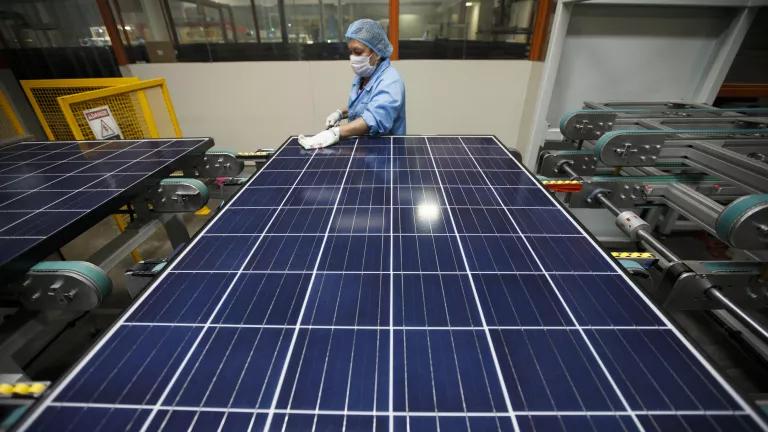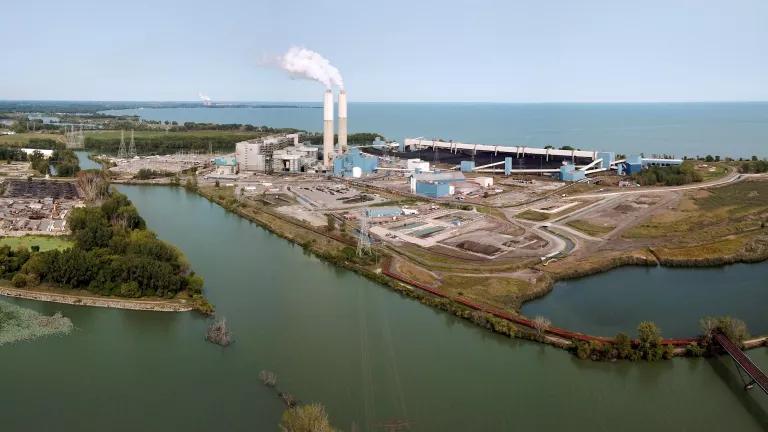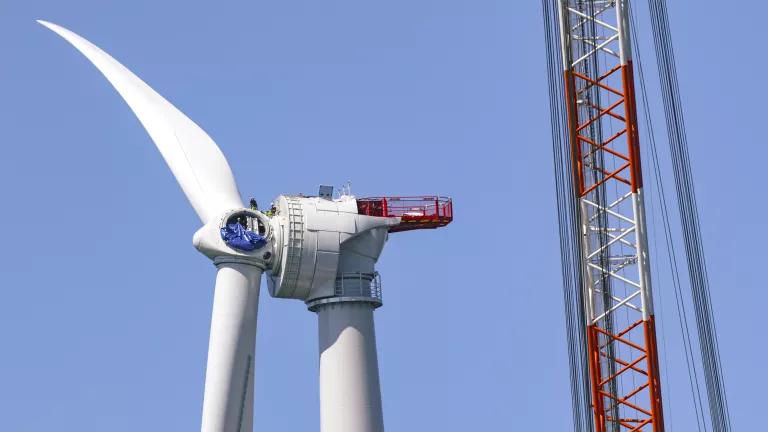New Book Puts Human Face on Epic Clean Energy Boom
Bob Keefe’s “Clean Economy Now: Stories from the Frontlines of an American Business Revolution” tells the story of our manufacturing renaissance.

A worker inspects newly made solar panels at the SunSpark Technology manufacturing facility in Riverside, California.
Patrick T. Fallon/Bloomberg via Getty Images
A manufacturing renaissance is sweeping the heartland with clean energy at its core, part of what President Biden calls “the greatest comeback story never told.”
Author Bob Keefe just let the cat out of the bag, masterfully telling this epic tale in his groundbreaking new book, Clean Economy Now: Stories from the Frontlines of an American Business Revolution.
For anyone who wants to grasp the clean energy boom that’s reshaping the economy, creating generational opportunity for American workers, and strengthening our hand in the climate fight, this is essential reading.
In sharp and vivid prose, Keefe takes readers behind the headlines and onto the factory floors where a stunning bid—worth some $120 billion and counting—is playing out to get this country off the sidelines and into the forefront of the global quest for clean energy primacy.
“We can lead the world in the most important economic transition in history,” former California governor Arnold Schwarzenegger writes in the book’s foreword. “We have the technology…(we) have the policy…and we certainly have the need.”
In the skillful hands of Keefe, a seasoned journalist-turned–entrepreneurial advocate, we learn what’s at stake for the country in the boldest economic play of our time—and the critical role of public policy in supporting it.
“We are in the middle of an economic and environmental transformation like no one has ever seen before,” Keefe writes, “forever changing the future of our nation and civilization writ large.”
In a masterpiece of solid reporting that reads in places like a high-tech thriller, Keefe tracks the innovation and investment that’s creating good-paying jobs, transforming the American economy into a clean energy dynamo, and strengthening the supply chain for the building blocks of a modern society.
He has a gift for summing up the sweep of this epic shift.
“If projections are right,” Keefe writes, “wind energy in America will double by 2030. Solar energy will triple. Battery storage will increase by a factor of nine. And the number of EVs (electric vehicles) on the road will increase twenty-six-fold.”
Concludes Keefe: “Very few industries will ever see that sort of growth rate in that amount of time.”
In this compact and tightly written volume, Keefe delivers a tour d’horizon of a clean energy boom grounded in new, expanded, and reopened factories to build solar panels in Georgia, wind turbines in Iowa, electric vehicles in South Carolina, and advanced batteries to power them all in Kentucky, Michigan, and Ohio.
He takes us to Louisiana and Mississippi, states that are rapidly turning into solar energy powerhouses; to Texas and New Mexico—the nation’s number one and number two oil producers, respectively—where some of the country’s largest wind and solar farms are underway; and to West Virginia, where the state’s largest collection of solar panels is being built on the site of an abandoned coal mine.
“Similar transformations are happening all across the country,” Keefe writes, “bringing new opportunities to cities and counties left behind by the industries of America’s past; connecting them to the rest of the world and the economy of the future; and remaking the country, sometimes in unusual ways that could never have been imagined before.”
In addition to reporting on this new economy, Keefe introduces us to a cast of entrepreneurs, community leaders, electricians, assembly line workers, and others who see in their jobs not just a paycheck but also a purpose: to do their part to confront the climate crisis that threatens our future.
More than simply echoing the optimism of others, Keefe brings to the story his own hopeful vision of a cleaner, more equitable, and more prosperous future for those who, like his three daughters, will inherit the world as we leave it.
Keefe cut his teeth three decades ago on reporting about plant closures and mass layoffs in textile towns across the American South.
For him, the clean energy investment rejuvenating the heartland is a long-in-coming breath of fresh air, a vote of confidence in an American future lit with promise, and a reminder of this country’s long tradition of picking itself up from a blow.
Never far from this hopeful story, though, is the mission behind the clean energy boom: confronting the rising costs and mounting dangers of the widening climate crisis. Keefe brings the latest reporting to the issue in a way that points to the costs of not acting and the benefits of acting now.
A former Washington correspondent for the Atlanta Journal-Constitution, Keefe leans into his journalistic skills to lay out the dramatic legislative backstory behind the strongest climate action in history: the Inflation Reduction Act.
Authoritative, yet never pedantic, Keefe takes us into marathon secret negotiations over nine steamy July days to land the bill, providing $370 billion in climate and clean energy incentives over 10 years. He compares that investment, both in scope and public benefits, to President John F. Kennedy’s moon shot program and President Dwight D. Eisenhower’s interstate highway project.
Beyond reporting on the Inflation Reduction Act, Keefe has tracked its impact—more than $120 billion in private investments and counting, mostly to build factories to make solar panels, wind turbines, electric vehicles, and advanced batteries while creating more than 100,000 jobs in red states and blue.
It’s the story of that investment, and the far larger economic shift it’s advancing, that Keefe tells in Clean Economy Now.
A former journalist who wrote for two decades at the intersection of business, high tech, and public policy for papers like the Austin American-Statesman and the St. Petersburg Times, Keefe is executive director of E2 (Environmental Entrepreneurs).
An NRDC affiliate, E2 is a national, nonpartisan group of business owners, investors, and professionals who leverage economic research and their business perspective to advance policies that are both good for the environment and good for the economy.
Keefe brings a deep background to his subject. He authored the 2022 book, Climatenomics: Washington, Wall Street and the Economic Battle to Save our Planet.
In an age when misinformation abounds, Keefe’s new work is meticulously researched and definitively sourced, documented in 35 pages of footnotes.
Keefe, though, isn’t writing to empty his notebook. He chooses details that nail down his points, quotes that bring the story to life, and just enough color to move the narrative along and make the book a joy to read.
A career writing for newspapers left Keefe with a keen grasp of the essence of economics. It’s not about statistics; it’s about people. It’s about you and me, the skills we bring, and the choices we make to feed our families, better our lives, and create a brighter, more hopeful future.
If you’re searching for hope that the country can rise to meet the existential challenge of our time, this book documents the gains on the ground.
If you’ve wondered whether U.S. manufacturers can compete with foreign rivals to build the solar panels, wind turbines, electric vehicles, and advanced batteries we need to break our dependence on fossil fuels, this book shows how and where we’re doing exactly that.
If you’ve ever thought politicians were spinning a false choice between economic growth and a sustainable future, this book lays that myth to rest, chapter and verse.
And if you’re exhausted by high-octane rhetoric and politically charged screeds, you’ll be relieved by the scrupulously bipartisan focus Keefe brings to the opportunities fanning out across red states and blue.
“If ever there was a time when we needed to tame the ugly beast of partisan politics, it’s now,” writes Keefe. “The opportunity for a cleaner, more resilient, more equitable, and more competitive economy is on our front doorstep. The howling specter of climate change and the prospect of increasingly unlivable parts of our planet are pounding at the back door.”



